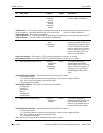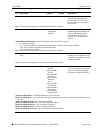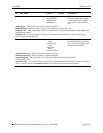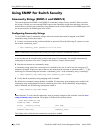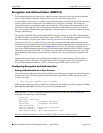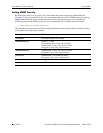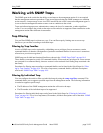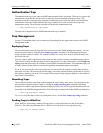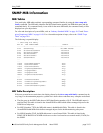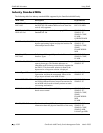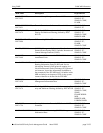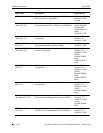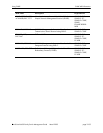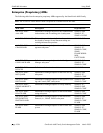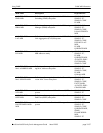
Working with SNMP Traps Using SNMP
page 10-30 OmniSwitch 6600 Family Switch Management Guide March 2005
Authentication Trap
The authentication trap is sent when an SNMP authentication failure is detected. This trap is a signal to the
management station that the switch received a message from an unauthorized protocol entity. This
normally means that a network entity attempted an operation on the switch for which it had insufficient
authorization. When the SNMP authentication trap is enabled, the switch will forward a trap to the
management station. The following command will enable the authentication trap:
-> snmp authentication trap enable
The trap will be suppressed if the SNMP authentication trap is disabled.
Trap Management
Several CLI commands allow you to control trap forwarding from the agent in the switch to the SNMP
management station.
Replaying Traps
The switch normally stores all traps that have been sent out to the SNMP management stations. You can
list the last stored traps by using the show snmp trap replay command. This command lists the traps
along with their sequence number. The sequence number is a record of the order in which the traps were
previously sent out.
You may want to replay traps that have been stored on the switch for testing or troubleshooting purposes.
This is useful in the event that any traps are lost in the network. To replay stored traps, use the snmp trap
replay command followed by the IP address for an SNMP management station. This command replays (or
re-sends) all stored traps from the switch to the specified management station on demand.
If you do not want to replay all of the stored traps, you can specify the sequence number from which the
trap replay will start. The switch will start the replay with a trap sequence number greater than or equal to
the sequence number given in the CLI command. The number of traps replayed depends on the number of
traps stored for this station.
Absorbing Traps
The switch may send the same traps to the management station many, many times. You can suppress the
transmission of identical repetitive traps by issuing the snmp trap absorption command. When trap
absorption is enabled, traps that are identical to traps previously sent will be suppressed and therefore not
forwarded to the SNMP management station. The following command will enable SNMP trap absorption.
-> snmp trap absorption enable
To view or verify the status of the Trap Absorption service, use the show snmp trap config command.
Sending Traps to WebView
When WebView forwarding is enabled, all traps sent by switch applications are also forwarded to
WebView. The following command allows a WebView session to retrieve the trap history log.
-> snmp trap to webview enable



